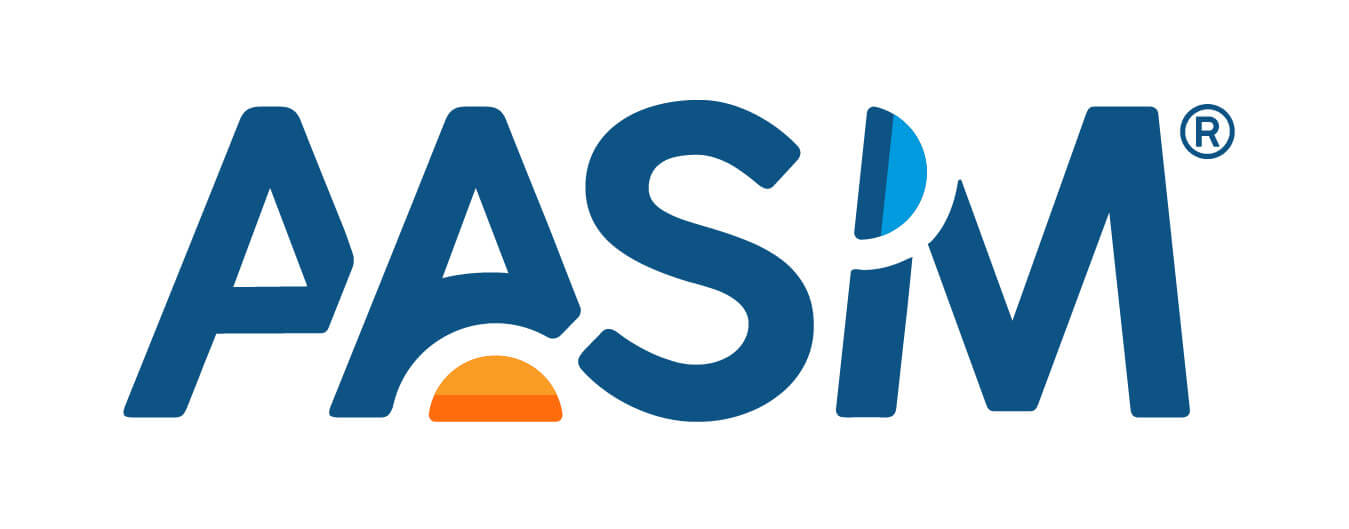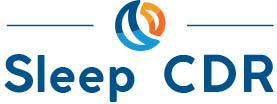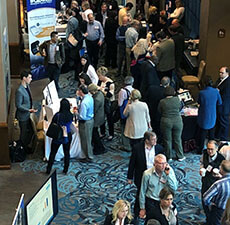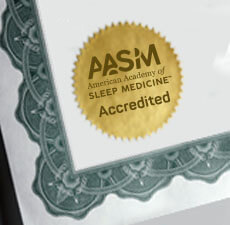Sleep Facility Accreditation
Who Should Apply?
AASM offers accreditation to comprehensive sleep centers that have a clinic, where patient evaluation and management occurs, and a laboratory, where diagnostic testing is administered through in-center sleep testing and home sleep apnea testing (HSAT).
Pricing
Facility Accreditation Fee | New Application
Reaccreditation Fee | Facility Member
Reaccreditation Fee | Non-Member Facility
Entities may be eligible for volume pricing. Visit the Accreditation Network webpage to learn more.
Members Save!
Join AASM membership and save on reaccreditation fees. AASM Facility Members also gain access to benefits including maintenance of accreditation, a listing on SleepEducation.org, discounts on training materials, and more. View full benefits and apply today.
Sleep Facility FAQs
Sleep Facility Information
A comprehensive sleep program that has a clinic, where patient evaluation and management occur, and a laboratory, where diagnostic testing is administered through in-center sleep testing and home sleep apnea testing (HSAT).
Sleep Facility Accreditation is $4,500 for a new application or an entity that is reaccrediting and has active membership. The reaccreditation fee for non-members is $7,200.
The accreditation term is granted for five years.
In general, accreditation can take 3-4 months to complete from application submission to the AASM Accreditation Committee’s approval. The AASM offers an expedited option for an additional $500. The expedited review allows the application to be approved in an average of 1-2 months.
Sleep facilities that have been operational less than 6 months, or not yet have opened, must complete a new accreditation application. Upon approval from the AASM Accreditation Committee, accreditation will be granted requiring a site visit to be completed within 12 months from the date of approval.
Six (6) months from the date of approval, the facility will be required to access their application and enter the previous 6 months patient volume and study statistics data, as well as, one full quarter quality assurance report. Following the review of this information, the program will be contacted to schedule their site visit. The site visit must occur within 12 months from the date of approval.
You must apply for reaccreditation of your Sleep Facility to maintain accreditation. Reaccreditation applications are opened 10 months prior to the expiration date. Applications for reaccreditation are due 6 months prior to the expiration date. The Accreditation Department will send notices 10 months and 7 months prior to the expiration date. The Sleep Facility can apply after the due date; however, a late fee will apply. If the Sleep Facility fails to submit a reaccreditation application by the accreditation expiration date, the Sleep Facility must submit a new online application. Please note that there are no extensions granted past the accreditation expiration date.
Yes, the AASM Accreditation Reference Manual available in either a digital or physical copy found on the Online Store. This easy-to-use guide provides concrete examples of policies, procedures, forms and documents required per Accreditation Standards. These samples are provided to assist in customizing your policies and procedures according to the specific needs of your sleep facility. Tabbed sections enable you to quickly access the information needed.
If a physician’s private practice is not associated with the sleep lab (i.e. not serving as the sleep clinic), these patients would not be included in the Patient Volume and Sleep Study Statistics section of the application. However, if the private practice directly refers patients to the Sleep Facility for testing, the total will need to be reported in the direct referral column. To address specific circumstances, please contact the AASM Accreditation Department.
A sleep facility, as defined by the AASM, is composed of a laboratory (where patients are tested), and a clinic (where patient consultation and management are offered by medical staff members). Under Standard G-1, the facility must demonstrate management of an adequate range of sleep disorders.
The AASM does not accredit sleep labs or independent diagnosing testing facilities that only provide testing without availability for patient management (clinical services).
When logged in to your AASM account, navigate to the “My Organizations” tab on the left-hand side of the page. At the bottom of this page, click on the “Manage Applications” link. This should route you to your past applications submitted with the AASM.
Accreditation Process and Policies
We only request that the sleep facility update the AASM on a change of facility director or primary contact. All other professional or technical staff members must be updated at the time of reaccreditation. Please ensure these new members are adhering to the qualifications in the Standard B section included in the AASM Standards for Accreditation.
Yes. Facilities that are undergoing one or more of these changes must submit a Special Considerations application within one month of the change. Please see Program Changes webpage on how to submit a Special Considerations application as well as the materials needed for submission.
When a sleep program relocates, the AASM requires accredited sleep programs to complete and submit a Special Circumstance Application within 90 days of relocation. The Special Circumstance Application allows the accreditation to be continued from your previous location to your new location of operations. To open the Special Circumstance Application, log-in to your AASM account and navigate to My Organizations. Please select “Request Change” under the sleep facility relocating and select “Relocation” in the Special Consideration Change Request form. Once the application has been opened, update the information for each section pertinent to the new location.
If the sleep facility is relocating within 18 months of their expiration date, they can choose to pursue an early reaccreditation application. Continued accreditation at the new location will be contingent on the AASM Accreditation Committee’s approval. Please reference Page 15 of the AASM Accreditation Process and Policies for further information on the Special Circumstances process.
If the facility is relocating and changing ownership simultaneously, the facility will be considered a new sleep facility and must submit a new application for accreditation. Please see the AASM Accreditation Process and Policies for more information.
No, AASM accreditation is location specific. Your facility accreditation only applies to the address of the accredited center. For this reason, satellite labs or additional centers would not fall under your accreditation. Each location would need to obtain separate accreditation by submitting a new accreditation application.
After the site visit, the sleep facility can expect their decision letter and site visit report within four to six weeks. The accreditation packet will be sent to the mailing address included in your file. Programs issued provisos will receive their certificate following review and approval.
Standards for Accreditation
The Standards do not define who can interpret sleep studies. It is at the facility’s discretion to decide who may interpret; however, only licensed physicians, and Advanced Practice Providers in some states, may diagnose a medical condition, and all individuals must practice within the limits of their license or scope of practice. Standard F-8 requires diagnoses made by individuals not board-certified in sleep medicine be reviewed by an individual who is board certified in sleep medicine.
Yes; it must be indicated on the report that the diagnosis has been reviewed by the individual board certified in sleep medicine.
The AASM defines a direct referral as a patient that is tested by the facility but is not seen by facility professional staff prior to or after the test for follow-up. For example, if a patient comes to your facility for testing only and returns to their primary physician (not associated with your sleep facility) for follow-up and treatment, the patient would be considered a direct referral.
Per the AASM Standards for Accreditation, all technical staff are required to earn 30 credits (averaged 10 credits per year over the past 36 months) of sleep-related continuing education credits; however, for a newly hired sleep technologist, the AASM may accept CECs prorated based on the hire date. For example, if a technologist has been working for the sleep program for one year, the AASM will require 10 sleep-related continuing education credits.
Per the AASM Standards for Accreditation, advanced practice provider (NP, PA, APRN) medical staff members are required to earn 30 continuing education credits (averaged 10 credits per year over the past 36 months) earned in sleep medicine; however, for a newly hired advanced practice provider (NP, PA, APRN), the AASM may accept continuing education credits prorated based on the hire date. For example, if an advanced practice provider (NP, PA, APRN) has been working for the sleep program for one year, the AASM will require 10 continuing education credits earned in sleep medicine.
Under the AASM Standards for Accreditation, all AASM-accredited sleep facilities must have the capability to conduct home sleep apnea testing (HSAT) as part of their sleep program. This includes developing HSAT policies and procedures, having access to a HSAT device, and having the ability to conduct HSAT when needed. Please note that your sleep facility can rent HSAT equipment or have an arrangement with a separate entity to access a HSAT device when needed.
The sleep facility has the option to contract home sleep apnea testing. Please see Standard F-9 – Subcontracting HSAT for additional information.
According to the AASM Practice Parameters, only patients 18 years or older should be tested using HSAT. If your sleep facility sees only patients 17 years of age or younger, you will not be required to maintain an HSAT program.
Per Standard B-13, each facility shall comply with all background check requirements which may be required by federal, state or local law. In the absence of such requirements, the facility shall conduct criminal background checks of all new employees. The facility shall utilize information obtained in this process only to the extent such information is relevant to the job duties of a particular person.
Yes. Per Standard I-4, all facilities, at a minimum, must have either an automated external defibrillator (AED) or access to an on-site medical emergency response team (typically available in hospital-based facilities).
Facilities must employ at least one sleep technologist that is registered in sleep technology or accepted to sit for the registry examination through one of the following organizations:
- American Board of Sleep Medicine (ABSM)
- Registered Sleep Technologist (RST)
- National Board for Respiratory Care (NBRC)
- Registered Respiratory Therapist – Sleep Disorder Specialist (RRT-SDS)
- Board of Registered Polysomnographic Technologists (BRPT)
- Registered Polysomnographic Technologist (RPSGT)
- Another organization that offers an equivalent examination accepted by the AASM
The registry exam must be passed within one year from acceptance to sit for the examination. The individual(s) fulfilling this standard must be present at the facility at least 30 hours per week. If the facility is open fewer than 40 hours per week, then the registered technologist(s) must be present at the facility for 75% of operating hours. A facility that loses its sole registered technologist will have 120 days to fulfill this standard.
The AASM Standards do not specify a dimension requirement for sleep testing bedrooms. However, each room must be single occupancy, private and comfortable, have hard floor-to-ceiling walls, and a privacy door that opens directly to a corridor or common use area. Patient testing bedrooms must not have any impediments to the delivery of emergency care. The patient testing rooms must be of sufficient size to accommodate emergency personnel access with a minimum of 24 inches of available clear space on three sides of the bed, which must be at least a standard hospital bed.
For additional physical space requirements, please reference Standards D-5 through D-10.
Yes. All members of the technical staff, regardless of job duties, must be certified in CPR per Standard B-9.
The AASM is not able to provide recommendations for programs that provide HSAT. It is the facility’s decision to choose a subcontracting company, provided that the subcontractor meets all applicable AASM HSAT Standard requirements.
Indicate within the application that the facility is subcontracting HSAT. The request for HSAT policies and procedures in the application will be determined based on the elements of HSAT that are subcontracted. Although the sleep facility is subcontracting their HSAT services, they will continue to be responsible for patient management, diagnosis, and reporting HSAT quality assurance. Subcontracted HSAT staff and the HSAT contract will not be requested within the application.
Technologists scoring as part of a subcontracting company should not be listed within the application; however, they must still meet all applicable accreditation requirements as part of the subcontracting agreement found under Standard F-10 – Subcontracting Scoring. Minimally, the subcontracting scoring company will need to be identified in the application.
Per Standard F-10, the facility is responsible for assessing the performance of the subcontractor in meeting contractual obligations including meeting applicable AASM Accreditation standards for scoring personnel (ex. Standard F-7 – Inter-scorer Reliability). Therefore, your written agreement with the subcontractor must enumerate the performance expectations of the subcontractor including adherence to application AASM Standards. The subcontracted scoring contract will not be requested in the application.
For the Facility Quality Assurance program, facilities must have a QA program that addresses the following indicators:
- A process measure for OSA;
- An outcome measure for OSA;
- An outcome measure for another sleep disorder (e.g. RLS, Insomnia or Narcolepsy); and
- Inter-scorer reliability as outlined in Standard F-7.
For questions on specific measures, please contact the AASM Accreditation Department. For more information regarding Quality Assurance, please review the AASM’s published Quality Measures.
The 2019 Standards for Accreditation removed the requirements to maintain a HSAT QA program. This revision comes from an understanding that clinical outcomes are not determined by the type of test (i.e. a patient’s clinical outcome for OSA would be the same whether the patient received an in-lab test or HSAT); therefore, requiring a quality assurance program specific to in-lab and HSAT testing has been removed.
Yes, the sleep facility’s quality assurance program data can be obtained from patients tested for in-center and home sleep apnea testing that resulted in an OSA diagnosis.
The Standards do not define the minimum threshold (%). The quality assurance program, with oversight by the Facility/Director/Principle Medical Staff Member/Medical Director, can assign minimum thresholds to their process or outcome measures that meets the practice’s goals.
The Facility Director must review, report, and manage the quality assurance program on a quarterly basis as mandated in the Section J Standards. Quarterly, the Facility Director must attest to the effectiveness of quality improvement efforts and address plans for remediation of metrics that do not meet the minimal threshold. Quarterly reports must be signed and dated by the Facility Director and maintained for at least five years.
The Quality Assurance FACT Sheet provides general information on a quality assurance program. A sample quality assurance template report is available via Accreditation Reference Materials webpage.
The AASM Standards allow for the sleep lab and clinic to be in separate physical location. The AASM defines sleep facility as the sleep lab and clinic collectively, even if they are in separate physical locations. Regardless of the location of the clinic (i.e. within the center, in a physician’s separate office, etc.), it is considered part of the sleep facility and must provide information required for the sleep facility to meet these standards.
The Standards require that the sleep facility maintains all clinical information, including the PAP assessment data specifically required by Standard H-2 for applicable patients, and quality assurance data required by Standards J-1-J-2 for each patient seen or tested in their medical record. The AASM Standards do not specify the location where the medical records must be held (i.e. the clinic vs. the lab) but these records must be maintained and accessible by the sleep facility.
The sleep facility is not required to have this information for patients that are directly referred for testing only; Standard H-2 only applies to patients who are prescribed PAP by sleep facility staff.
The following strategies can be utilized to gain access to data that is needed to meet these standards:
- The clinic and lab can have a Business Associate Agreement to address the sharing of PHI and share data with the lab accordingly.
- The clinic can have patients give consent to sharing the data with the lab.
- The clinic can provide the data needed to measure the QA indicators to the lab de-identified. This would address any HIPAA concerns the clinic may have.
- The clinic can maintain the QA measures for clinic specific measures and report results to the lab for inclusion in the larger QA report.
It is important that the clinic understand that it is their responsibility, as clinic of the accredited sleep facility, to ensure that the facility as a whole is able to meet all accreditation standards.
Business Associate Agreement (BAA)
The HIPAA Privacy Rule explicitly defines organizations that accredit covered entities as business associates. Like other business associates, accreditation organizations provide a service to the covered entity which may require sharing of protected health information.
The AASM offers a BAA that covers in-scope accreditation services. The AASM’s HIPAA BAA is available in the accreditation application or on the accreditation Reference Materials webpage. The AASM recommends the entity uses a pre-signed AASM BAA found in the accreditation application, which can be e-signed and submitted.
The AASM’s services are consistent for all entities; therefore, the AASM strongly recommends use of the AASM HIPAA BAA. In creation of AASM’s HIPAA BAA, the AASM had the BAA vetted by legal counsel specializing in HIPAA privacy. The AASM HIPAA BAA satisfies all requirements of business associates under HIPAA regulations.
Entities wanting to pursue a custom BAA may select “Custom BAA” in the accreditation application. A custom BAA must be uploaded in the accreditation application and a fee of $500 is payable at the time of the accreditation application submission. Customized agreements require careful review by the AASM and may require direct communication with the entity’s legal department. Entities pursuing a custom BAA need to allow an average of 4-6 weeks for review and potential revisions before the agreement is ready for signature.
The AASM does not create, maintain, or transmit any PHI of the covered entity. During the accreditation process, a site visitor will conduct an inspection of the entity to determine compliance with the Standards for Accreditation. During this inspection, our site visitor will review a set of patient records prepared by the entity. The site visitor will neither copy nor remove any PHI from the entity. Additionally, the AASM does not accept any PHI in response to additional information in support of the standards.
The BAA is a legal document only valid when signed by an authorized individual designated to review and approve official legal documents on behalf of an accrediting entity. Typically, hospital owned entities require a CEO’s or privacy officer’s signature. Freestanding entities may have the owner sign all legal documents. Entities applying for accreditation are responsible for determining the appropriate signatory ensuring that an authorized individual has reviewed and signed the agreement.




